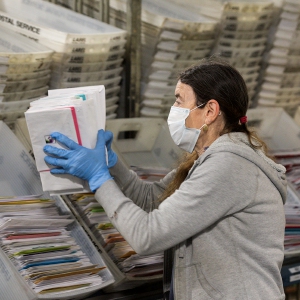The public health emergency has ended; here’s what is changing for Granite Staters
| Published: 05-13-2023 7:58 PM |
Some of the government’s biggest pandemic protections ended months or longer ago.
Those include the December 2021 termination of temporary changes to the child tax credit and February’s end of increased food stamp assistance, protections that experts said led to a drop in child poverty. Before that, the government eliminated expanded unemployment benefits, and in March, the states, including New Hampshire, began disenrolling people who no longer qualify for Medicaid, moving many of them onto other insurance options.
Thursday’s end of the federal public health emergency brought to a close more pandemic assistance that will impact hospitals and COVID testing, vaccinations and treatment.
Hospitals had considerable flexibility during the pandemic to respond to an unprecedented health crisis. That flexibility ended Thursday or will end in the coming months.
Prior to the pandemic, the state’s many “critical access hospitals” were limited to 25 beds and a 96-hour hospital stay for each patient. Those rules were set aside during the pandemic to allow hospitals to treat more people.
The end of the public health emergency means those limits are back even as patient demand remains high. That’s a worry, said Steve Ahnen, president and chief executive officer at the New Hampshire Hospital Association.
“We will be watching that closely as the demand for care and higher acuity for patients has gone up so that it doesn’t have an impact on patient access to care,” he said.
Until the pandemic, Medicare required patients to remain in the hospital for three days before they could be transferred to a skilled nursing facility. That rule was set aside until Thursday’s end of the public health emergency, meaning patients could be transferred sooner, to free up hospital beds.
Article continues after...
Yesterday's Most Read Articles
 Dartmouth administration faces fierce criticism over protest arrests
Dartmouth administration faces fierce criticism over protest arrests
 West Lebanon crash
West Lebanon crash
 Plan on track to ship Upper Valley mail to Connecticut for sorting
Plan on track to ship Upper Valley mail to Connecticut for sorting
 Lebanon’s Jewell back from auto accident, more aware of ‘drowsy driving’ dangers
Lebanon’s Jewell back from auto accident, more aware of ‘drowsy driving’ dangers
 Longtime employees buy West Lebanon pizzeria
Longtime employees buy West Lebanon pizzeria
“Obviously, we’re concerned about what the implications are for that, particularly given the high volume of patients that we’re seeing,” Ahnen said.
Hospitals have been allowed to monitor a patient remotely during diagnostic services. That will end in December.
“That’s a workforce issue, and it’s a workforce challenge,” Ahnen said. “And it’s certainly one that will challenge us to make certain that we have those clinicians on site at all times when those services are being provided.”
The state’s hospitals and providers welcomed law changes that have required insurance companies to cover telehealth visits. Ahnen called it a “shining example” of what worked well during the pandemic. He’s concerned that telehealth coverage is set to end in December for Medicare patients.
“Medicare is the largest payer in the country,” Ahnen said. He and others are advocating for Medicare to continue paying for telehealth visits. “While we’re certainly not in the throes of the pandemic as we once were, the ongoing challenges and continued issues relative to workforce and access remain.”
Department of Health and Human Services spokesperson Jake Leon said the state will continue to offer free telehealth treatment for COVID-19 through Aug. 31 through its partner, On-Site Medical Services. For more information, visit on-sitemedservices.com/telemedicine or call 800-816-5802.
Dartmouth Health launched a long-COVID clinic in 2021 to help patients connect with resources and to better understand the symptoms associated with the condition. Dartmouth Health spokesperson Cassidy Smith said the clinic will remain open.
So far the Post-Acute COVID Syndrome Clinic has received about 1,600 referrals and seen about 600 patients. Smith said there has been no let-up in referrals.
The pandemic also prompted the state’s hospitals to begin working closely with one another to secure masks, gloves and gowns; share resources; and even take one another’s patients when needed. Ahnen said that collaboration will continue — and needs to.
“I would say that certainly was a benefit of bringing all of the hospitals together, sharing information, sharing resources,” he said. “The (New Hampshire Hospital) Association has served as the connecting point, and we will continue to do that. Hopefully we’ll all benefit from that collaboration as we go forward.”
The end of the public health emergency also triggered some changes for COVID health insurance coverage.
The most significant change for those with private insurance is the end of free at-home COVID tests.
Insurance companies have been required to cover up to eight over-the-counter tests per individual per month. That requirement ended with the termination of the public health emergency.
Anthem and Harvard Pilgrim Health Care, two of the state’s three largest insurance carriers, told New Hampshire Bulletin they will no longer pay for at-home test kits but will continue to cover at least some costs of medically prescribed COVID tests with a co-pay.
Kimberly Winn of Point32Health, which includes Harvard Pilgrim Health Care, will do the same. However, Winn said members who purchased up to eight at-home tests will still be able to submit for reimbursement for tests they purchased before May 11.
Winn said self-insured employer groups may choose to continue covering tests and urged people with those plans to confirm their coverage options with their employer.
A two-test pack typically ranges from $20 to $24.
In an analysis released this week, the Kaiser Family Foundation said the median price of a COVID test in an outpatient clinical setting among those with large employer-based plans was $45 in 2021.
Winn and Stephanie DuBois, an Anthem spokesperson, said their companies will continue covering COVID vaccinations if provided by an in-network provider. Most Anthem plans will not require a co-pay for vaccines, according to its website. It suggested subscribers check their plan’s benefits.
Winn said their subscribers will pay nothing for in-network vaccines. However, if an in-network provider is unavailable, member cost-sharing will be waived for out-of-network COVID vaccinations. Winn said members should contact member services if they are unable to locate an in-network provider.
Harvard Pilgrim Health Care will continue covering medically necessary treatment for COVID with a co-pay.
DuBois did not respond to a question about Anthem’s coverage for COVID treatment, and the company’s website she referred the Bulletin to was unclear.
“Anthem will help you coordinate COVID-19 care,” it said.
The state has taken steps since the pandemic to ensure insurance coverage is available for telehealth visits. Individuals should check with their plan about that coverage.
Medicare recipients also saw the end of free at-home tests Thursday. But like those on private insurance, they will pay nothing for testing that is ordered by a provider.
Vaccines will remain free for Medicare Part B recipients. Those with Medicare Advantage plans can continue to receive vaccinations at no cost from in-network providers.
Medicare will also continue its coverage for COVID treatments, according to guidance from the Centers for Medicare and Medicaid Services (CMS). In cases where cost sharing and deductibles apply now, they will continue to apply. The end of the public health emergency won’t change access to oral antivirals, such as Paxlovid and Lagevrio, while federal supplies last.
Telehealth services will continue unchanged for Medicare recipients, including visits from their homes through Dec. 31, 2024.
As a result of the American Rescue Plan Act, states must provide those on Medicaid and the Children’s Health Insurance Program (CHIP) coverage, without cost-sharing, for COVID vaccinations, testing and treatments through Sept. 30, 2024.
After that, many Medicaid and CHIP enrollees will continue to have coverage for COVID vaccinations, but coverage of COVID treatments and testing may vary by state. Telehealth visits will continue to be covered.
The CDC stated in a May 5 update that it will continue offering free testing at pharmacies participating in the Increasing Community Access to Testing program. To search for a New Hampshire location, visit testinglocator.cdc.gov.
The federal government will continue offering free vaccines to uninsured children and those unable to pay, according to the CDC website.
The Department of Health and Human Services will continue to offer free vaccines through its mobile van until May 31, Leon said.
The schedule is available online at on-sitemedservices.com/vaccination-map.
The Department of Health and Human Services has maintained a dashboard of COVID metrics and weekly updates of new deaths and the number of patients being treated for COVID in a hospital. In its most recent update on May 4, it reported five new deaths and 10 hospitalizations, a significant drop from January 2022 when hospitalizations peaked at 433.
Leon did not say whether those updates will continue. And the dashboard will change, he said, but he offered few details.
He said the department will continue to partner with select communities to monitor wastewater for the presence of COVID. That information will continue to be shared on the new dashboard, a metric on the current dashboard, he said.
But doctors and health care providers no longer need to report information about positive COVID cases to the New Hampshire Division of Public Health Services, he said.
That data has become increasingly unreliable as more people test at home and don’t report results.
Leon said recommendations for who should receive updated boosters will continue to evolve. The CDC has published new guidance for COVID vaccinations for people who are immunocompromised and those who are not. Those include new recommendations for the number of vaccines.
Leon referred people with questions or concerns about COVID protections to their primary care providers, especially individuals who are at higher risk for severe COVID, such as older adults and people with compromised immune systems.
The site has been a critical source of information about deaths, outbreaks, hospitalizations and statewide hotspots. It also tracks the levels of COVID levels in wastewater and cases within individual schools.
The New Hampshire Hospital Association had been providing the public daily updates on the number of COVID patients in the state’s hospitals, in part to show the strain the pandemic was having on health care providers. It is now reporting those numbers on its website weekly.
In its most recent report, dated May 11, the state’s hospitals counted 18 patients who were recovering from COVID and 11 who were being treated for the virus.


